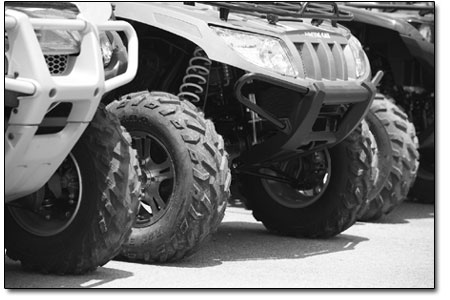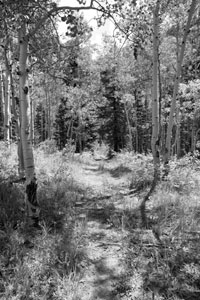|
| ||||
| A recreation reprimand
by Will Sands
Back in 2004, Forest Service Chief Dale Bosworth named ORV abuse as a top threat to public lands. The move came in response to huge growth in motorsports and the sudden appearance of more than 60,000 miles of renegade routes on forests throughout the nation. At the time, Bosworth spoke out of both sides of his mouth and said, “Our goal is to improve opportunities for off-highway vehicles and assure the best care of the land.” Bosworth then ordered regional and local offices to confine motorized travel to designated roads and trails. The San Juan National Forest immediately picked up the charge and took a progressive approach to the order. Rather than upping enforcement, the local agency worked to enhance the motorized experience in certain areas and attract users to motorized sanctuaries. The San Juan’s first experiment was “The Lakes” landscape, which stretches between Lemon and Vallecito reservoirs and includes portions of Missionary Ridge and Middle Mountain. Two years ago, the agency officially opened The Lakes and designated 52 miles of roads and trails to motorized travel. “We’ve been going through the forest, looking at different landscapes and identifying where it makes sense to have motorized travel,” explained Matt Janowiak, Columbine District Ranger. “We’re trying to be very deliberate and get motorized users onto the right routes and roads.” But now that The Lakes has been open for business, some riders have struggled to play by the rules. Repeated violations and trespass into the Weminuche Wilderness may lead to the closure of a portion of the motorized meccas. The Middle Mountain Road, above Tuckerville, has been especially problematic as ORVs have strayed beyond “closed” signs and into the wilderness area, where motors are strictly prohibited. “This is year two of implementation, and we had violations last year, and again this year,” said Janowiak. “If we see this pattern continue, we will close this portion of the road next year." The Forest Service has stepped up its patrols on Middle Mountain and started issuing tickets. In addition, the agency plans to monitor The Lakes for another year. If the violations continue, a large portion of the Lakes will be closed to motorized access. Great Old Broads for Wilderness, a Durango-based conservation group, is stepping up education efforts at Middle Mountain. The group will be helping with signage and closures and conducting volunteer monitoring. “Our belief is that if you can’t manage it, don’t open it,” said Ronni Egan, executive director of the Broads. “So we’re going to be helping the Forest Service with signs and barriers, and then we’re going to go out there and monitor to see that they’re effective.” Egan added that the Broads are not anti-motor and respect the multiple-use doctrine. However, she added that each user has a responsibility to respect the land, follow the rules and police themselves. “We are of the opinion that there’s plenty of room for everybody out there,” she said. “But people need to play by the rules, and that means exercising some self-restraint. The only way this is going to work is if people can learn to police themselves.” Motorized excesses in La Plata Canyon have also drawn the eye of the Forest Service. The La Plata Mountains are a big draw for motorized users during summer months, and this popularity has not come without costs to the land. “Because the route up La Plata Canyon is a county road, people have been taking their ATVs off road and riding up the canyon parallel to the road so they can avoid a fine,” Janowiak explained. “Riders are also going beyond the ends of Forest Service roads, creating two-tracks and extending these routes into places where they shouldn’t be."
In response, the Forest Service issued an ORV closure order for the La Platas earlier this spring. The order confines motorized use to existing roads until the agency can complete a planning process, much like what was done for the Lakes. That process is set to begin this fall. “We issued a closure order where we made it clear and official that motorized travel is limited to Forest Service roads in the La Platas,” said Janowiak. “We’re trying to put the brakes on violations until we can designate a trail network and establish routes up there.” The San Juan Trail Riders, a motorized recreation advocacy group, recognizes that there are problems on Middle Mountain and elsewhere in the San Juans. However, the group added that change comes slowly and encouraged patience on the part of the public and foresters. “Anytime there’s a change from cross-country travel to designated routes, it takes a while for the public to get a handle on it,” said Gary Wilkinson, president of the Trail Riders. “The Lakes may be signed, sealed and delivered on paper, but that doesn’t mean it’s working on the ground yet.” As processes move forward in the Lakes and the La Platas, Wilkinson urged compromise over confrontation. He said that he believes the motorized community will come to respect the Weminuche Wilderness closure and noted that the Trail Riders are eager to work toward solutions in other areas. “As a motorized user, it really bothers me when the answer is ‘shut it off,’” Wilkinson said. “There’s always another way, and maybe we need to figure that out rather than just closing things down.” Janowiak gave credit where credit is due and noted that the majority of motorized users are playing by the rules and keeping their knobbies on route and on road. “By and large, we have areas with good use and lots of responsible riders staying on route and following the rules,” he said. “But I would characterize a few areas as problem areas, places where we have chronic violations with vehicles going off road and doing serious damage.” With this in mind, he added that all users must get on board and respect a shared public resource. Egan and Wilkinson agreed. “If people want to retain their chosen sport, they’re going to have to learn how to live within the limits,” Egan said. “There are no easy answers out there,” Wilkinson added. “Playing well together is tough.” •
|



 The Forest Service is applying the brakes on off-road vehicle abuse in Southwest Colorado. A few bad throttles have been bending the rules, and the agency is now addressing motorized violations with a firmer hand.
The Forest Service is applying the brakes on off-road vehicle abuse in Southwest Colorado. A few bad throttles have been bending the rules, and the agency is now addressing motorized violations with a firmer hand.